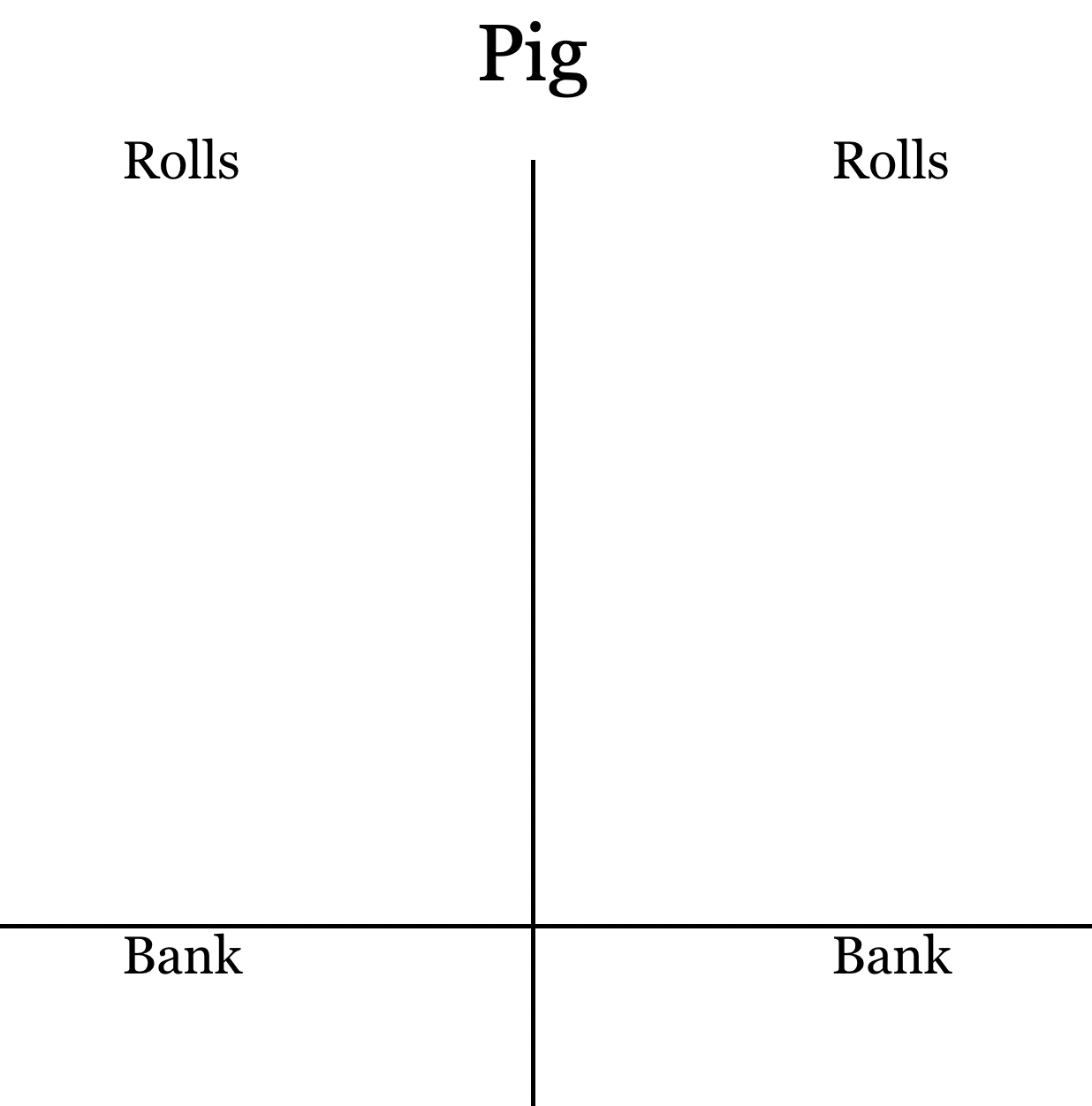Get tons of free content, like our Games to Play at Home packet, puzzles, lessons, and more!

Overview
Topics: probability, strategy, addition, estimation
Materials: One 6-sided die, pencil and paper
Recommended grades: 1, 2, 3, 4, 5, 6
Common Core:
For Pig and Big Pig: 1.OA.A.1, 1.OA.A.2, 1.NBT.C.4, 2.OA.B.2, 2.NBT.B.5, 2.NBT.B.6, 3.NBT.A.2
For Odd Pig Out: 3.OA.A.3, 3.OA.B.5, 3.OA.C.7 , 4.NBT.B.4,, 4.NBT.B.5, 4.MD.B.4,, 5.NBT.B.5, 5.MD.B.2, 6.SP.A.1, 6.SP.A.2, 6.SP.A.2, 6.SP.B.5
Roll the dice and collect points. You can go as long as you want, but roll the wrong number and you lose all your points from that turn!
Why We Love Pig
Pig is easy to learn and gives students abundant addition practice. But more centrally, Pig is mathematically very rich. Students get to articulate and defend strategies, and get their practice with addition in a complex task.
How to Play
Pig is a game for 2 to 6 players. Players take turns rolling a die as many times as they like. If a roll is a 2, 3, 4, 5, or 6, the player adds that many points to their score for the turn. A player may choose to end their turn at any time and “bank” their points. If a player rolls a 1, they lose all their unbanked points and their turn is over.
Beginner’s Game: The first player to score 50 or more points wins.
Advanced Game: The first player to score 100 or more points wins.
Variations
Big Pig
This variation is played with two dice. It is like Pig: on your turn you can roll or hold. If you roll a 1, you lose your points for that turn and your turn ends. However, you roll a pair of 1s, add 25 to your turn total. If other doubles are rolled, the player adds twice the value of the dice to the turn total. Play to 150.
Odd Pig Out
Roll two dice and multiply them. You can keep rolling as long as the product is even. If the product is odd, you lose all unbanked points for that turn, and pass the dice. Play to 500.
Questions
There are several central questions in Pig:
- Does strategy matter?
- If it does, what is the best strategy?
Good questions for the teacher to ask the students:
- Do you have a strategy? What is it?
- How do you know your strategy works? How could you test it?
- What happens when you play your strategy against another student’s different strategy?
- Between these two strategies (name two collected from the class), who do you think will win?
Possible student conjectures, true and false, that may arise:
- Strategy doesn’t matter. The game is all luck.
- Strategy does matter.
Common strategies:
- Roll up to a specific value and then stop.
- Roll a certain number of times and then stop.
- Roll until your total will beat your opponents’ and then stop.
Tips for the classroom
- Demonstrate the game a couple times with the whole class. Solicit advice from the class about when you (the teacher) should stop rolling on your turn.
Students can give you a thumbs up if they think you should continue rolling, and a thumbs down if they think you should stop. - For students who are less confident with addition, use tens frames and counters or a hundreds chart to keep track of the score.
For example, students get to pick counters up as they roll. If they stop before they roll a one, then they transfer those counters to their tens frames.
Fill up 4 (or 5) tens frames to win. - Remind students that they will lose games and win games, and each loss can be a chance to re-examine how they are playing.
- As kids play each other, circulate the room and ask them about their strategies.
It’s ok for students simply to play, but there’s an opportunity to probe deeper into the workings of chance and the strategy of the game too. - Stir up controversy! Encourage students to stake a claim, either that strategy does matter and which, or that it does not matter.
Encourage students with different conjectures to play each other. Ask them if the results change their minds. Don’t use the position of the teacher to evaluate their conjectures. Instead, let the game give them feedback. - (For more mature students, this can be a great opportunity to run the experiment detailed in the steps below.) It can be helpful to bring the whole class together for a discussion about whether strategy matters and if so, which ones are best.
Here we like to highlight contrast by picking two extreme strategies: Roll once and stop, and Roll until you get a 1 or win the game.
(We sometimes refer to these as “Slow and Steady” and “Let it Ride”).
If these two extreme opposite strategies were pitted against one another, which would win?
This is a good chance to poll the room.
Be sure to include a third option, that they are equally good strategies. - Test it! Half the students play “Slow and Steady”, half play “Let it Ride”, and pair them up.
Have each pair play a couple games and keep track of which strategy prevailed. - Share the data. What do you find? Does the result change anybody’s mind?
- Homework: Have students teach Pig to someone at home and play.
 back to FreeLessons
back to FreeLessons